

A standard, also called a pizaine, was a collar of mail often worn with plate armour.


A standard, also called a pizaine, was a collar of mail often worn with plate armour.
The standard protected the throat and neck and usually extended over the shoulders; it was in use from the 14th to the 16th century. Unlike the similar aventail, it was not attached to a helmet. It was called a standard because the part encircling the neck and throat was able to stand upright without any external stiffening. This part of the standard was composed of links joined 6-in-1, which made it less flexible and also stronger; the usual, more flexible, ratio of mail linking was 4-in-1. The lower, shoulder-covering, part of the standard was of 4-in-1 linked mail. Some standards were decorated with edging in brass or bronze links (sometimes gilded), and/or were given a zig-zag lower edge (vandyked). [1]
Standards were sometimes worn under an aventail, or even a gorget, for extra protection. However, standards were often worn without other neck protection by soldiers who valued an unencumbered facility to move the head over additional protection. Standards were popular with archers, whose mobility was at a premium. Standards were frequently worn with helmets that did not afford integral neck and throat protection, such as the sallet, barbute, and kettle hat. [2] [3] [4]

Chain mail is a type of armour consisting of small metal rings linked together in a pattern to form a mesh. It was generally in common military use between the 3rd century BC and the 16th century AD in Europe, and longer in Asia and North Africa. A coat of this armour is often referred to as a hauberk, and sometimes a byrnie.

To improve motorcycle safety many countries mandate the wearing of personal protective equipment such as protective clothing and helmets. Protective clothing may include certain types of jackets, gloves, boots, and pants. Jackets meant for motorcyclists are typically made of leather or specialized man-made fabrics like cordura or Kevlar. These jackets typically include padding on the elbow, spine, and shoulder regions. This was once quite bulky, but modern technology and materials have made it unobtrusive. Gloves are generally made of leather or Kevlar and some include carbon fiber knuckle protection. Boots, especially those for sport riding, include reinforcement and plastic caps on the ankle and toe areas. Pants are usually leather, cordura, or Kevlar. Except for helmets, none of these items are required by law in any state in the USA, or in any part of the UK but are recommended by many of those who ride.

The sallet was a combat helmet that replaced the bascinet in Italy, western and northern Europe and Hungary during the mid-15th century. In Italy, France and England the armet helmet was also popular, but in Germany the sallet became almost universal.

The bascinet – also bassinet, basinet, or bazineto – was a Medieval European open-faced military helmet. It evolved from a type of iron or steel skullcap, but had a more pointed apex to the skull, and it extended downwards at the rear and sides to afford protection for the neck. A mail curtain was usually attached to the lower edge of the helmet to protect the throat, neck and shoulders. A visor was often employed from ca. 1330 to protect the exposed face. Early in the fifteenth century, the camail began to be replaced by a plate metal gorget, giving rise to the so-called "great bascinet".

An aventail or camail is a flexible curtain of mail attached to the skull of a helmet that extends to cover the throat, neck and shoulders. Part or all of the face, with spaces to allow vision, could also be covered.
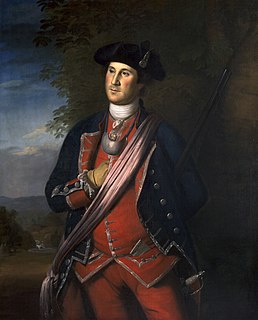
A gorget, from the French gorge meaning throat, was a band of linen wrapped around a woman's neck and head in the medieval period or the lower part of a simple chaperon hood. The term later described a steel or leather collar to protect the throat, a set of pieces of plate armour, or a single piece of plate armour hanging from the neck and covering the throat and chest. Later, particularly from the 18th century, the gorget became primarily ornamental, serving as a symbolic accessory on military uniforms, a use which has survived in some armies.
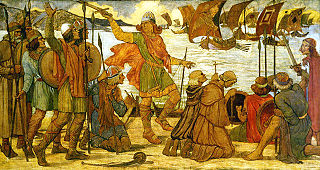
Knowledge about military technology of the Viking Age is based on relatively sparse archaeological finds, pictorial representation, and to some extent on the accounts in the Norse sagas and laws recorded in the 14th century.

The armet is a type of helmet which was developed in the 15th century. It was extensively used in Italy, France, England, the Low Countries and Spain. It was distinguished by being the first helmet of its era to completely enclose the head while being compact and light enough to move with the wearer. Its use was essentially restricted to the fully armoured man-at-arms.

A brigandine is a form of body armour from the Middle Ages. It is a garment typically made of heavy cloth, canvas, or leather, lined internally with small oblong steel plates riveted to the fabric, sometimes with a second layer of fabric on the inside.

Scale armour is an early form of armour consisting of many individual small armour scales (plates) of various shapes attached to each other and to a backing of cloth or leather in overlapping rows. Scale armour was worn by warriors of many different cultures as well as their horses. The material used to make the scales varied and included bronze, iron, steel, rawhide, leather, cuir bouilli, seeds, horn, or pangolin scales. The variations are primarily the result of material availability.

The great helm or heaume, also called pot helm, bucket helm and barrel helm, is a helmet of the High Middle Ages which arose in the late twelfth century in the context of the Crusades and remained in use until the fourteenth century. The barreled style was used by knights in most European armies between about 1220 to 1350 AD and evolved into the frog-mouth helm to be primarily used during jousting contests.
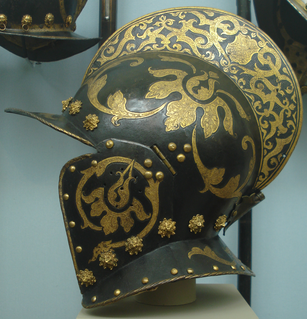
The burgonet helmet was a Renaissance-era and early modern combat helmet. It was the successor of the sallet.
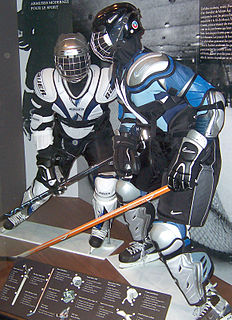
In ice hockey, players use specialized equipment both to facilitate the play of the game and for protection as this is a sport where injuries are common, therefore, all players are encouraged to protect their bodies from bruises and severe fractures.
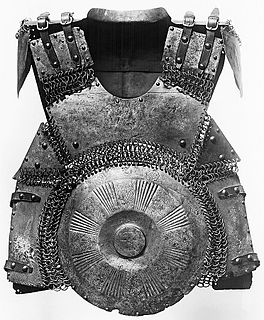
Mirror armour, sometimes referred to as disc armour or as chahār-āyneh or char-aina, was a type of cuirass used mainly in Asia, the Middle East, and Eastern Europe; including Indian, Persia, Tibet, Russia, and the Ottoman Empire. It literally translates to "four mirrors" which is a reflection of how these pieces looked, which resembles four metal discs or rectangular armour plates. Mirror armor was used in some cultures up to the 20th century.

Scholars agree that Japanese armour first appeared in the 4th century, with the discovery of the cuirass and basic helmets in graves. It is thought they originated from China via Korea. During the Heian period (794-1185), the unique Japanese samurai armour ō-yoroi and dō-maru appeared. The Japanese cuirass evolved into the more familiar style of body armour worn by the samurai known as the dou or dō, with the use of leather straps (nerigawa), and lacquer for weatherproofing. Leather and/or iron scales were also used to construct samurai armours, with leather and eventually silk lace used to connect the individual scales (kozane) of these cuirasses. In the 16th century, Japan began trading with Europe, during what would become known as the Nanban trade. This was the first time matchlock muskets were imported, and as they became mass-produced domestically, samurai needed lighter and more protective armour. As a result, a new style of armour called tosei-gusoku (gusoku), which means modern armour, appeared. When a united Japan entered the peaceful Edo period, samurai continued to use both plate and lamellar armour as a symbol of their status.

Kusari gusoku (鎖具足) is the Japanese term for mail armour. Kusari is a type of armour used by the samurai class and their retainers in feudal Japan. When the word kusari is used in conjunction with an armoured item it usually means that the kusari makes up the majority of the armour defence.

A mail coif is a type of armour which covered the head. A mail coif was a flexible hood of chain mail that extended to cover the throat, neck and the top part of the shoulders. They were popular with European fighting men of the Middle Ages.

A Turban helmet is a variety of Turkish helmet specifically known for its bulbous shape and fluting that imitates the folds of a turban. Turban helmets originated in Ottoman Turkey, primarily used by warriors and some external attics.
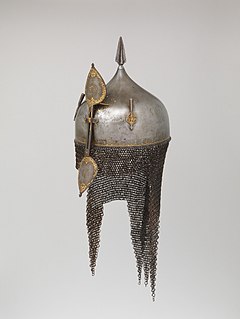
Kulah Khuds were used in ancient western Asia for battle and as decorative head pieces.